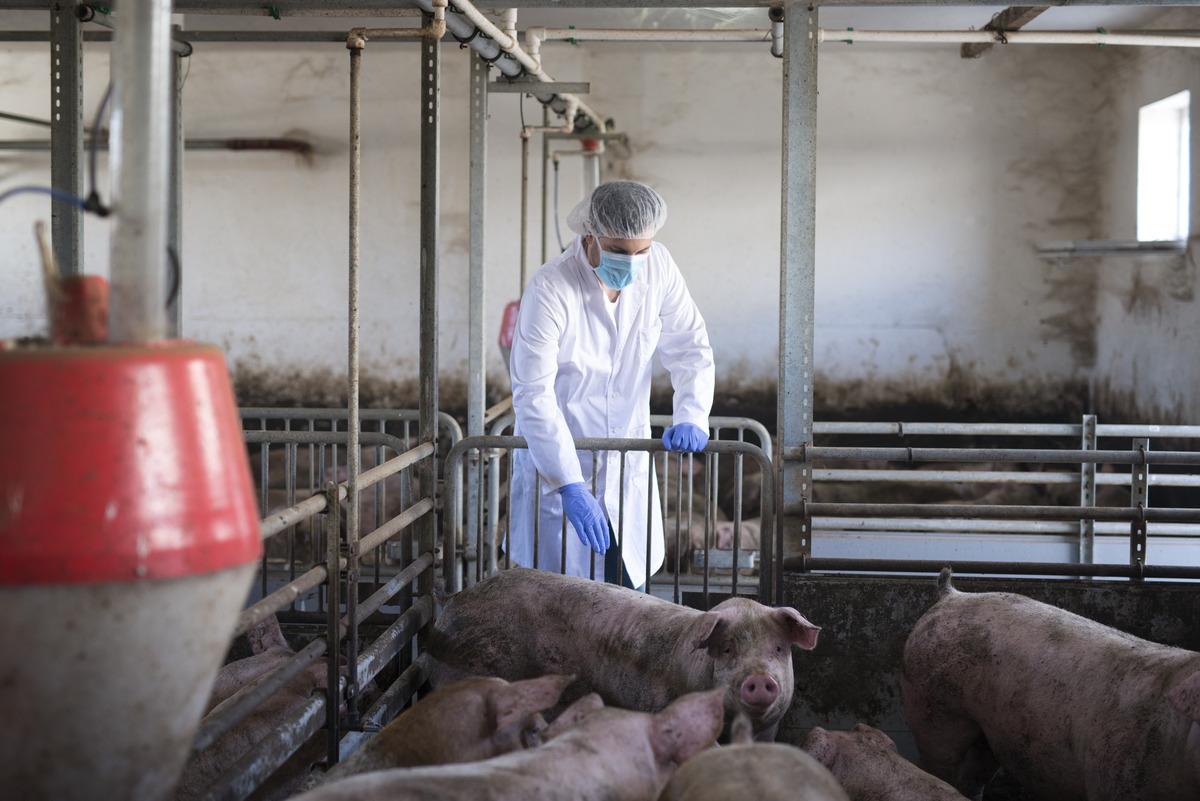Understanding swine diseases is pivotal in the livestock industry. It helps to maintain pig health, productivity, and welfare. Swine diseases can lead to significant economic losses due to decreased productivity and increased mortality rates. Natural causes or the introduction of new animals into a herd can lead to disease outbreaks. To ensure the well-being of these livestock, being able to identify symptoms and initiate early treatment is fundamental. An awareness of the most common swine diseases and their symptoms allows for more informed management practices, benefiting both the pigs and their caretakers.
Swine Influenza
Swine Influenza, also known as pig flu, is a highly infectious respiratory disease in pigs. It is caused by a specific strain of the influenza virus, which can be particularly aggressive. The key symptoms to look for include fever, coughing (“barking”), sneezing, breathing difficulties, eye inflammation, and going off feed. A drop in the pig’s energy level could be a preliminary sign. Sometimes, the pigs might show no signs but are carriers of the disease, making it even more critical to regularly monitor the herd’s health. Although the disease primarily affects pigs, if not well-managed, it can mutate and pose risks to humans. Having this knowledge of swine influenza is essential in managing healthy swine production.
Porcine Reproductive and Respiratory Syndrome (PRRS)
The Porcine Reproductive and Respiratory Syndrome (PRRS), frequently referred to as Blue-Ear Pig Disease, is another common disease amongst swine. PRRS is a viral infection known to cause severe reproductive failure in breeding stocks and respiratory tract illness in young pigs. Symptoms vary greatly but primarily include breathing difficulties, bluish discoloration of the skin (hence the name), and reduced milk production in sows. In breeding stocks, you may notice abortions, stillbirths, along with weak and undersized piglets. The disease poses a considerable threat as it can spread rapidly within a herd, emphasizing the importance of observing and identifying these key symptoms early. Implementing preventative measures and biosecurity protocols can help to mitigate the spread and impact of PRRS.
African Swine Fever (ASF)
African Swine Fever (ASF) is a highly contagious and lethal viral disease that affects domestic and wild pigs. It causes high fever, loss of appetite, hemorrhages in the skin, and internal organs leading to death within 2-10 days of infection. Symptoms also include vomiting, diarrhea, and impaired coordination. Due to its high mortality rate and the lack of vaccine or treatment, ASF is severe in swine populations. It’s crucial to notice these symptoms promptly and take swift action to isolate the diseased animals, as the virus can be spread through direct contact, ticks, or even feeding pigs with waste food. Knowing how to identify ASF greatly contributes to the overall health and well-being of the pig population.
Classical Swine Fever (CSF)
Classical Swine Fever (CSF) is a highly contagious viral disease that can cause severe illness in pigs of all ages. It’s important to identify quickly as it can spread through direct contact or indirectly through feed and equipment. Pigs suffering from CSF often exhibit a range of symptoms, including high fever, loss of appetite, weakness, and skin discolorations. Additional signs may include constipation followed by diarrhea, blotchy skin, and severe weight loss. In chronic cases, pigs may exhibit nervous system symptoms like tremors and stiffness coordination. Early identification of these symptoms allows for the rapid response needed to prevent a widespread outbreak of CSF. As there’s no cure, prevention, such as proper biosecurity measures, is integral to protecting swine populations from this disease.
Porcine Epidemic Diarrhea (PED)
Porcine Epidemic Diarrhea (PED) is a viral disease that primarily affects piglets, causing severe diarrhea, vomiting, and in severe cases, high mortality rates due to dehydration. PEDs are highly contagious and can spread rapidly in swine populations. Gastrointestinal symptoms suggestive of PED should be taken seriously, and at the first sign, pigs should be isolated. The infection is typically more deadly in piglets because they become dehydrated more quickly than older swine. In older pigs, the symptoms can be less severe, and they can recover if well-managed. Prompt recognition of these symptoms and quick response are vital for limiting the spread and impact of PEDs. Implementing good hygiene practices and maintaining strict biosecurity is crucial for prevention.
Swine Vesicular Disease
Swine Vesicular Disease is a viral illness in pigs that closely resembles Foot and Mouth Disease. It is crucial to identify as it can create trade restrictions due to its similarity. Symptoms of this disease include vesicles and blisters on the feet, snout, and in the mouth. Affected pigs may also experience lameness, fever, and loss of appetite. In severe cases, sudden death may occur. It is notable that a proportion of infected pigs may not exhibit clinical signs but can still spread the virus. Hence, vigilance in observing any changes in swine health and behavior plays a critical part in controlling the spread. Early detection and containment can prevent the disease from infecting the entire herd.
Porcine Circovirus Associated Disease (PCVAD)
Porcine Circovirus Associated Disease (PCVAD), also known as Porcine Circovirus 2, is a multifaceted viral disease in pigs. Symptoms often include weight loss, difficulty in breathing, enlargement of lymph nodes, and diarrhea. In its more severe forms, you can notice a range of other signs, including pale skin, jaundice, and red spots across the pig’s body. This disease has a significant impact on the overall performance and growth of the affected pigs, impacting the productivity of the herd. The wide range of symptoms associated with PCVAD makes early diagnosis a challenge. Therefore, a keen eye for changes in a pig’s behavior and consistent monitoring can ensure early detection and management to improve overall herd health.
Porcine Enteric Colibacillosis
Porcine Enteric Colibacillosis is a frequent bacterial infection in pigs, mainly affecting the gastrointestinal tract. The most common sign is diarrhea, particularly in piglets, which may be mild to severe. In severe cases, tissues may be present in the diarrhea, leading to dehydration and potential death if not addressed promptly. Other signs include loss of appetite, weight loss, and piglets showing signs of stress. It’s crucial to identify these symptoms as early as possible and to isolate infected pigs, reducing the risk for the entire herd. With prompt action and attention, this common swine disease can be managed and controlled, ensuring the well-being and productivity of your swine operation.
Actinobacillus Pleuropneumonia (APP)
Actinobacillus Pleuropneumonia (APP) is a bacterial infection causing respiratory illness amongst swine. The disease is of significant concern as it can result in severe economic losses due to high morbidity and mortality rates. Infected pigs may exhibit symptoms such as difficulty breathing, coughing, high fever, and lack of appetite. In its acute form, pigs may suddenly die without showing previous symptoms. Chronic forms, however, may lead to less severe respiratory signs and slow growth rates. Early detection, based on these symptoms, can help manage the situation, preventing an all-out outbreak in your swine operation. Alongside, maintaining proper sanitary conditions and biosecurity protocols can considerably reduce the risks associated with APP.
Atrophic Rhinitis
Atrophic Rhinitis is a contagious disease in pigs that mainly affects the upper respiratory tract. It’s characterized by the distortion and atrophy of the pig’s nasal bone and tissues. Early symptoms include sneezing, nasal discharge, and slow growth even when the pig’s appetite seems normal. In severe cases, the pig’s snout may appear twisted. This disease reduces the overall productivity of the pig as it has a direct effect on weight gain and feed efficiency. Early identification of symptoms allows for the right course of treatment, preventing the disease from spreading and causing more damage. Regular health check-ups and good biosecurity measures can dramatically decrease the instances of Atrophic Rhinitis.
Key Takeaway
Understanding and identifying symptoms early can significantly alleviate the impacts of swine diseases on the entire herd’s health, welfare, and productivity. The ability to recognize signs of the most common swine diseases helps ensure the well-being of your swine population and contributes to the sustainability and profitability of pig farming. Awareness also informs disease prevention strategies, allowing for prompt veterinary intervention when required. Always remember, that the key to effectively managing swine diseases is early detection, excellent hygiene, and maintaining strict biosecurity measures.




